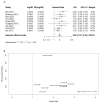Multi-Omics Classification of Intrahepatic Cholangiocarcinoma: A Systematic Review and Meta-Analysis
- PMID: 39061233
- PMCID: PMC11275091
- DOI: 10.3390/cancers16142596
Multi-Omics Classification of Intrahepatic Cholangiocarcinoma: A Systematic Review and Meta-Analysis
Abstract
Intrahepatic cholangiocarcinoma (ICC) is a heterogeneous disease characterized by a dismal prognosis. Various attempts have been made to classify ICC subtypes with varying prognoses, but a consensus has yet to be reached. This systematic review aims to gather relevant data on the multi-omics-based ICC classification. The PubMed, Embase, and Cochrane databases were searched for terms related to ICC and multi-omics analysis. Studies that identified multi-omics-derived ICC subtypes and investigated clinicopathological predictors of long-term outcomes were included. Nine studies, which included 910 patients, were considered eligible. Mean 3- and 5-year overall survival were 25.7% and 19.6%, respectively, for the multi-omics subtypes related to poor prognosis, while they were 70.2% and 63.3%, respectively, for the subtypes linked to a better prognosis. Several negative prognostic factors were identified, such as genes' expression profile promoting inflammation, mutations in the KRAS gene, advanced tumor stage, and elevated levels of oncological markers. The subtype with worse clinicopathological characteristics was associated with worse survival (Ref.: good prognosis subtype; pooled hazard ratio 2.06, 95%CI 1.67-2.53). Several attempts have been made to classify molecular ICC subtypes, but they have yielded heterogeneous results and need a clear clinical definition. More efforts are required to build a comprehensive classification system that includes both molecular and clinical characteristics before implementation in clinical practice to facilitate decision-making and select patients who may benefit the most from comprehensive molecular profiling in the disease's earlier stages.
Keywords: bile duct cancer; classification; intrahepatic cholangiocarcinoma; molecular signature; multi-omics.
Conflict of interest statement
The authors declare no conflicts of interest.
Figures
References
-
- Nagtegaal I.D., Odze R.D., Klimstra D., Paradis V., Rugge M., Schirmacher P., Washington K.M., Carneiro F., Cree I.A., WHO Classification of Tumours Editorial Board The 2019 WHO classification of tumours of the digestive system. Histopathology. 2020;76:182–188. doi: 10.1111/his.13975. - DOI - PMC - PubMed
-
- Banales J.M., Cardinale V., Carpino G., Marzioni M., Andersen J.B., Invernizzi P., Lind G.E., Folseraas T., Forbes S.J., Fouassier L., et al. Expert consensus document: Cholangiocarcinoma: Current knowledge and future perspectives consensus statement from the European Network for the Study of Cholangiocarcinoma (ENS-CCA) Nat. Rev. Gastroenterol. Hepatol. 2016;13:261–280. doi: 10.1038/nrgastro.2016.51. - DOI - PubMed
Publication types
LinkOut - more resources
Full Text Sources
Miscellaneous



